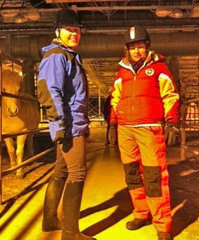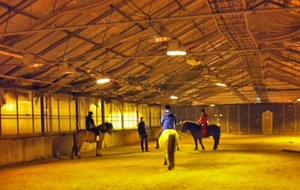One woman's return to riding: Icelandic horses in a greenhouse in Norway

Ase and friend Linda dressed for the elements and ready to ride.
Kathy Lundberg | Contributor
My sister-in-law, Ase, invited me to visit the stable where she takes riding lessons with a couple of friends.
Ase is 40-something, a generally athletic person, with an adventurous spirit. As a kid, she and her friends hung around the local racetrack to work (gratis) around the horses. The track races Standardbreds, the fastest horses under harness. The girls did barn chores, worked their way up to grooming, walking and occasionally riding the horses.
As you can imagine, inexperienced tween girls riding horses bred and trained to race did not always make a great combination. Many wild rides and spills occurred. Undaunted, the girls started taking actual lessons at another barn.
Life changed over years with school, work, family, etc. Horses faded from the picture for a few decades, but now Ase is ridng again.
We arrived a few minutes early to look around the Vikinghest Riding Center and to give Ase time to locate, groom and tack the horse she was to ride. The owner, Asmund Bryn, was just finishing a lesson with four girls of about 12 and stopped to talk to us.
Asmund was born to a family in the florist business. He was raised on the property where they plied their trade, and still lives there. In addition to traditional greenhouse gardening, Asmund’s parents developed a tropical garden destination on a windswept island off the coast of Stavanger in the chilly North Sea. Clearly, these people think outside the box.
Business at the home base was slow, especially in the long winter. Considering ways to make use of the extensive greenhouses and grounds, Asmund decided to start a riding school.
He learned to be a farrier (one who trims and shoes horses' feet), brushed up on his own riding and bought a string of Icelandic horses and their tack. He converted the greenhouses to an indoor riding center, complete with two indoor arenas, spacious tacking and grooming area and multiple indoor paddocks for winter use. Outdoor arenas are available for use when the weather permits, and one can ride on trails and along the road.
Asmund is a real “can-do,” optimistic kind of guy. Five years later, his plan is working just fine.

Riders listen to trainer Asmund in the spacious greenhouse arena.
Why Icelandic horses?
“They are the true horses of the Vikings, brought to Iceland years ago” Asmund reminds me.
Actually, he adds, about 30 percent of their ancestry can be attributed to ponies and horses from the British Isles. After generations of surviving the difficult terrain and weather conditions in Iceland, an exceptionally hardy breed emerged.
They get along well together and require little feed; they are strong, with good endurance. Iceland horses are of fairly consistent size (13-14 hands, or 52-56 inches), so saddles and bridles are easily fitted between them. They are large and sturdy enough to carry an adult — such as Asmund, who is about 6’2” — of medium build, yet small and gentle enough to be confidently handled by children.
As former greenhouses, the facility has plenty of natural light through the translucent plastic walls and ceiling during the daytime and electric light for the long winter nights. The footing was based on small gravel, amended with organic material. Most of the saddles were dressage-based, and generally no saddle pad was used.
All the ponies wore four shoes. None wore blankets, as they were protected by their own woolly coats and shielded from the weather inside the enormous complex of greenhouses. The horses lived in indoor paddocks, happily munching on round bales of hay.
They came right up to the indoor paddock fence as we walked by and frisked our pockets for treats. None of them seemed in need of extra calories — some were downright portly. A couple of horses stood patiently in the tacking area with saddles on, waiting to go to work in a lesson.
Ase and her friends prepared their mounts and followed Asmund to the arena they were to ride in. They donned their helmets, and mounted from a chair. The horses were warmed up, then put through their paces.
Despite the cold (about 18 degrees Fahrenheit) both riders and horses had a good workout. Afterward, horses were cooled down, untacked and brushed once again. Ase and her friends were happy with their riding experience.
They left looking forward to their next lesson at Vikinghest Riding Center, which offers recreational riding instruction in a comparatively economical way, in a unique, very functional setting.
Kathy Lundberg is a regular contributor to AnnArbor.com, where she writes about all things equine and is owner of Scio Church Stables. Reach her via e-mail.

